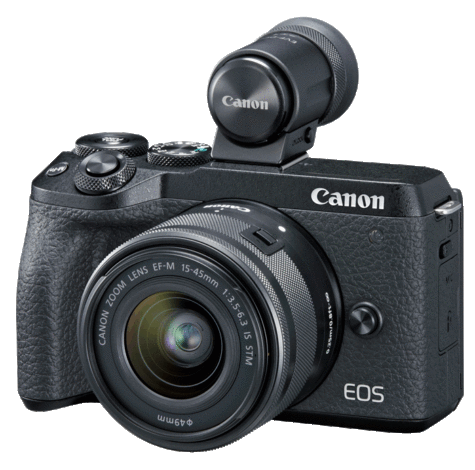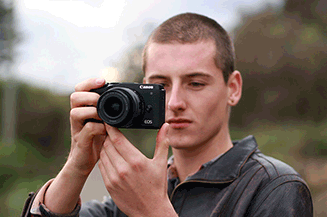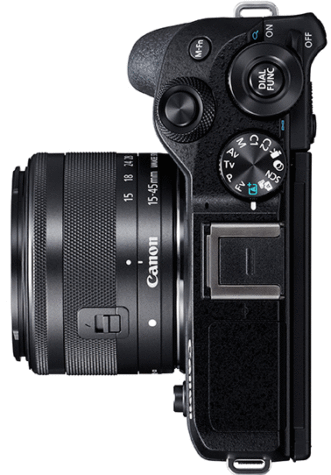CANON EOS M6 MII: The second generation model of Canon’s EOS M6 camera features the same 32.5-megapixel CMOS sensor and DIGIC 8 processor as the EOS 90D in a much smaller, lighter body. It will will appeal to travellers and those who want a compact, high-performance interchangeable-lens camera, but the add-on EVF is an issue: the overwhelming majority of serious photographers – the types of people who would want, and be prepared to pay for, the M6 II’s high resolution – will not want to use an LCD monitor for shot composition.
RRP: $1849 with EF-M 15-45mm IS STM lens (discounts available, so shop around).

The EOS M6 Mark II is, arguably, Canon’s closest attempt so far at producing a cropped-sensor interchangeable-lens mirrorless camera with real appeal to serious enthusiasts. As well as sharing the sensor and processor with its more traditional DSLR sibling, this pocketable camera offers most of the controls and functions found in the EOS 90D. But there are some important differences between them. Most notable is the fact that the viewfinder, which most photographers consider essential in any ‘serious’ camera, is a bundled add-on instead of being built in. In a camera that should appeal to travellers, that’s a problem because, while you can use the camera like a smartphone, it’s easier to frame shots with the EVF in most situations – but particularly when shooting video. Furthermore, the EVF adds bulk and weight to the compact camera body.
 Designing the monitor to flip up for taking ‘selfies’ is another hint this camera is pitched at snapshooters – although the relatively high price tag implies otherwise. As a result, you can’t use the flash when the monitor is up and it’s difficult to mount an external microphone on the hot-shoe. The latter reduces its value for serious vloggers.
Designing the monitor to flip up for taking ‘selfies’ is another hint this camera is pitched at snapshooters – although the relatively high price tag implies otherwise. As a result, you can’t use the flash when the monitor is up and it’s difficult to mount an external microphone on the hot-shoe. The latter reduces its value for serious vloggers.
On the plus side, eye detection autofocus technology can be used when shooting stills and movies, ensuring focus remains locked on the subject’s eyes. In addition, the EOS M6 Mark II is very well built, although it’s bundled with a cheap lens. It’s also a good performer with fast and accurate autofocusing, thanks to Canon’s Dual Pixel CMOS AF, which works whether or not you use the EVF. Resolution with the bundled 15-45mm lens is not as good as the EOS 90D’s, which comes with a better lens. In addition, lens options are also reduced with only eight ‘native’ EF-M lenses currently listed in Canon’s line-up.
Purchasing points:
1. This camera will appeal to travellers and those who want a compact, high-performance interchangeable-lens camera.
 2. The APS-C sized (22.3 x 14.8 mm) 32.5 megapixel CMOS sensor and DIGIC 8 image processor are the same as in the EOS 90D DSLR camera.
2. The APS-C sized (22.3 x 14.8 mm) 32.5 megapixel CMOS sensor and DIGIC 8 image processor are the same as in the EOS 90D DSLR camera.
3. Movies can be recorded in most shooting modes with auto or manual settings and the camera supports 4K UHD movie clips at 25p and 1080p FHD video recording at 100p without cropping the frame, so video footage has the same angle of view as stills.
4. The tilting monitor flips up through 180 degrees for ‘selfies’ and down through approximately 45 degrees. (Note that popping up the flash or slotting an external flash into the hot-shoe puts it in front of the flip-up screen, obstructing its field of view.)
5. Without the EVF attached, this camera slips easily into a jacket pocket, even with the 15-45mm kit lens fitted. The camera body weighs only 408 grams with battery and card and measures 119.6 x 70.0 x 49.2mm.
6. Continuous shooting is supported at up to 14 frames/second for JPEGs with a maximum rate of approximately 30 fps in the RAW burst mode.
7. Integrated Wi-Fi and Bluetooth connectivity provide easy image sharing and remote camera control via the quickly and easily with the Canon Camera Connect App. The Bluetooth connection can be used to provide automatic transfer of shots to a smartphone, even while the camera is in a camera bag.
8. This camera has a USB Type-C port, which can be used for charging the camera via an optional PD-E1 adapter without removing the battery.
Distributor: Canon Australia; 1800 021 167; www.canon.com.au.





Be First to Comment